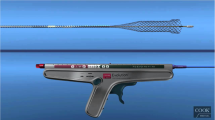Abstract
Introduction
In unresectable malignant bile duct obstruction, endoscopic stent insertion is the treatment of choice. However, the current stent allows only mechanical palliation of the obstruction, and has no anti-tumor effect. Currently, in the vascular field, the drug-eluting stent (DES) is very highly favored.
Material and methods
The requirements for a DES in a non-vascular tract, such as the bile duct, are far different from those of a DES to be used in the vascular tract. The non-vascular DES must suppress tumor proliferation as well as mucosal hyperplasia. For example, the non-vascular stent might be covered with a membrane that gradually releases a chemo-agent. We do not have much experience with DES in the bile duct. Nonetheless, we are continuously testing many anti-tumor agents in animal and human studies.
Conclusion
We expect and hope DES will work effectively for tumor cells in diverse ways and, more importantly, will prolong stent patency and the patients’ survival periods. But considerable investigation and a clinical study of DES will be required to achieve these goals.

Similar content being viewed by others
References
Machan L, Jessurun L, Hunter W, Arsenault L. Angiogenesis inhibitor-coated metallic stents in the porcine bile duct: prevention of benign reactive overgrowth. Radiology. 1995;197(Suppl 1):241.
Machan L, Hunter W. Angiogenesis inhibition as a means to prevent stent overgrowth. J Vasc Interv Radiol. 1997;8(Suppl 1):198–9.
Manifold DK, Cowling M, Maynard N, Machan L, Mason R, Adam A. Paclitaxel coated stents in oesophageal adenocarcinoma. Cardiovasc Intervent Radiol. 1998;21:S129.
Mezawa S, Homma H, Sato T, Doi T, Miyanishi K, Takada K, et al. A study of carboplatin-coated tube for the unresectable cholangiocarcinoma. Hepatology. 2000;32:916.
Lee DH, Kang SG, Jeong S, Yoon CJ, Choi JA, Byun JN, et al. Local delivery system of immune modulating drug for unresectable adenocarcinoma: in vitro experimental study and in vivo animal study. Cardiovascular and inter. Cardiovasc Intervent Radiol. 2006;29:832–7.
Uehara K, Ichida T, Sugahara S, Ishikawa T, Yamagiwa S, Yoshida Y, et al. Systemic administration of liposome-encapsulated OK-432 prolongs the survival of rats with hepatocellular carcinoma through the induction of IFN-gamma-producing hepatic lymphocytes. J Gastroenterol Hepatol. 2002;17:81–90.
Okamoto M, Oshikawa T, Tano T, Ohe G, Furuichi S, Nishikawa H, et al. Involvement of Toll-like receptor 4 signaling in interferon-gamma production and antitumor effect by streptococcal agent OK-432. J Natl Cancer Inst. 2003;95:316–26.
Nakahara S, Tsunoda T, Baba T, Asabe S, Tahara H. Dendritic cells stimulated with a bacterial product, OK-432, efficiently induce cytotoxic T lymphocytes specific to tumor refection peptide. Cancer Res. 2003;63:4112–8.
Takahashi K, Harauchi D, Kimura S, Saito S, Monden Y. OK-432 develops CTL and LAK activity in mononuclear cells from regional lymph nodes of lung cancer patients. Int J Immunopharmacol. 1998;20:375–88.
Oshikawa T, Okamoto M, Ohe G, Furuichi S, Nishikawa H, Ahmed S, et al. Anti-tumor immune response induced by the fractions derived from OK-432, a streptococcal preparation, by using a monoclonal antibody TS-2 that neutralizes the interferon-gamma-inducing activity of KO-432: comparison between the TS-2-binding and TS-2-unbinding fraction. Int Immunopharmacol. 2003;3:643–55.
Nishikido M, Kiyohara T, Koga S, Shindo K, Matsuya F, Saito Y, et al. OK-432-induced killer cell activity: potential method for monitoring immunological complications after renal transplantation. Nephrol Dial Transplant. 2001;16:2067–71.
Itoh T, Ueda Y, Okugawa K, Fujiwara H, Fuji N, Yamashita T, et al. Streptococcal preparation OK-432 promotes functional maturation of human monocyte-derived dendritic cells. Cancer Immunol Immunother. 2003;52:207–14.
Lee DK, Kim HS, Kim KS, Lee WJ, Kim HK, Won YH, et al. The effect on porcine bile duct of a metallic stent covered with a paclitaxel-incorporated membrane. Gastrointest Endosc. 2005;61:296–301.
Suk KT, Kim JW, Kim HS, Baik SK, Oh SJ, Lee SJ, et al. Human application of a metallic stent covered with a paclitaxel-incorporated membrane for malignant biliary obstruction: multicenter pilot study. Gastrointest Endosc. 2007;66:798–803.
Lee DH. Drug-eluting stent in gastrointestinal disease. Korean J Gastroenterol. 2007;49:294–9.
Mani G, Feldman MD, Patel D, Agrawal CM. Coronary stents: a materials perspective. Biomaterials. 2007;28:1689–710.
Machan L. Clinical experience and applications of drug-eluting stents in the noncoronary vascular, bile duct and esophagus. Adv Drug Deliv Rev. 2006;58:447–62.
Rowinsky EK, Donehover RC. Paclitaxel (Taxol). N Engl J Med. 1995;332:1004–14.
Kalinowski M, Alfke H, Kleb B, Durfeld F, Joachim Wagner H. Paclitaxel inhibits proliferation of cell lines responsible for metal stent obstruction: possible topical application in malignant bile duct obstructions. Invest Radiol. 2002;37:399–404.
Dhanikula AB, Panchagnula R. Localized paclitaxel delivery. Int J Pharm. 1999;183:85–100.
Wassef W, Syred I. Designer stents: are we there yet? Gastrointest Endosc. 2007;66:804–8.
Folkman J, Hochberg M. Self-regulation of growth in three dimensions. J Exp Med. 1973;138:745–53.
Hunter WL, Burt HM, Machan L. Local delivery of chemotherapy: a supplement to existing cancer treatments. A case for surgical pastes and coated stents. Adv Drug Deliv Rev. 1997;26:199–207.
Kabanov AV, Batrakova EV, Alakhov VY. Pluronic® block copolymers as novel polymer therapeutics for drug and gene delivery. J Controlled Release. 2001;70:157–67.
Acknowledgments
The author thanks Professor D. H. Lee (Department of Internal Medicine, Inha University, Incheon, Korea) and Professor K. Na (Division of Biosciences and Technology, Catholic University, Bucheon, Korea) for their assistance in preparing this manuscript.
Author information
Authors and Affiliations
Corresponding author
About this article
Cite this article
Lee, D.K. Drug-eluting stent in malignant biliary obstruction. J Hepatobiliary Pancreat Surg 16, 628–632 (2009). https://doi.org/10.1007/s00534-009-0135-1
Received:
Accepted:
Published:
Issue Date:
DOI: https://doi.org/10.1007/s00534-009-0135-1




